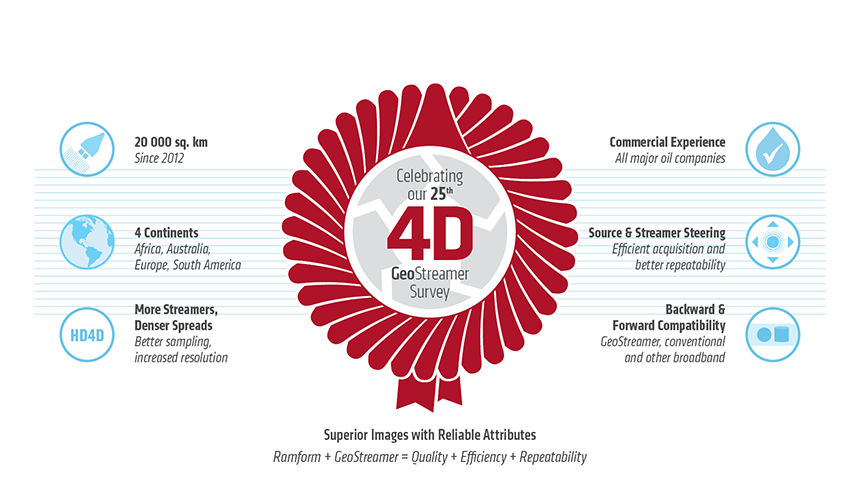This marks another milestone for GeoStreamer technology. These 25 surveys accumulate to 20 000 sq. km of multisensor 4D data. That is an impressive track record. The data quality and attribute reliability are particularly important when assessing production decisions. "PGS' experience in the acquisition of multisensor, true broadband HD4D data is unique in the marine seismic industry," says PGS Chief Geophysicist Martin Widmaier.
Early Beginnings in 2009
It is over a decade since PGS launched broadband GeoStreamer, the first multisensor towed streamer in 2007. The new technology made it possible to tow streamers deeper, without compromise, which resulted in step changes for both operational efficiency and data quality.
PGS acquired the first proprietary GeoStreamer 3D survey in 2009 offshore Norway for Lundin, over what became the Johan Sverdrup discovery. Straight afterward, they conducted a 4D repeatability and compatibility test over a shallow-towed conventional hydrophone-only survey in the same neighborhood, to prove the backward compatibility of the revolutionary new streamer technology. The 2009 experiment demonstrated high data quality and 4D repeatability. The convincing results were published in First Break in December 2010.
In 2010, a 4D qualification survey was carried out over a C02 sequestration site and the GeoStreamer monitor survey matched seamlessly with the 4D history of the storage field. The results were published at the EAGE in 2011.
Commercial Success
In 2012, PGS carried out three surveys for a major oil company in West Africa. Then the following year, 4D projects for four more majors offshore Angola, Australia, and Norway.
One of our clients made a memorable presentation on 4D seismic results from one of those GeoStreamer monitor surveys at the NPF Biannual Geophysical Conference in Kristiansand, Norway in 2014.
Flexible, Compatible, Repeatable
PGS has carried out numerous 4D seismic processing projects, proving repeatedly that high-quality GeoStreamer data can not only be matched (i.e. downgraded) to conventionally-acquired monitor or baseline data, but it can also be used to upgrade the legacy data in a 4D-friendly manner. GeoStreamer data acquired on top of slanted streamer solutions can also provide reliable 4D results.
Commercial multisensor-monitor-on-multisensor-baseline 4D surveys have now been acquired. Results from a 2015 test demonstrate high-quality 4D data for GeoStreamer "P-UP on P-UP" across an extended frequency bandwidth. Needless to mention, the P-UP 4D data is free from rough sea surface effects, providing an ideal foundation for high-resolution 4D and QI analysis.
Ramform + GeoStreamer = Quality, Efficiency, Repeatability
The success of GeoStreamer 4D is about more than the multisensor cable. Most of the 4D surveys are acquired with high-density configurations (HD4D). A typical configuration deploys 12-14 cables with a streamer separation of 50 m to ensure both dense receiver sampling as well as high repeatability. Some cases were acquired with 16 or even 17 streamers.
The PGS Ramform fleet is built to operate these dense spreads. Repeatability requirements are supported by advanced streamer steering technology (eBirds) and a source steering solution that is considered by many as the best in the industry. Shot-by-shot farfield signatures are offered as standard.
"Our unrivaled track record of 25 multisensor 4D projects is a result of pioneering technology, a high capacity seismic fleet, operational excellence, and geophysical competence," says Martin Widmaier.
There are positive signals that the 4D market will continue to grow in the next couple of years, there is a clear trend towards multisensor applications in 4D. If that prognosis proves true, then PGS is well-positioned to grow its market share in the high-end 4D market.
Click on the image to zoom
Contact a PGS expert
If you have a question related to our Marine Acquisition services or would like to request a quotation, please get in touch.
